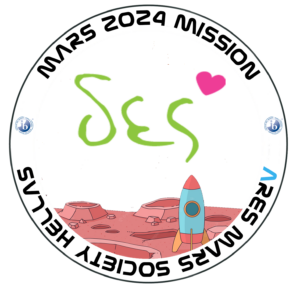DES@Mars 2024
The Concept

It is year 2047 and Mars planet has been inhabited by the first astronauts. As ‘New Martians’, their goal is to establish a viable community.
Ad Astra DES School Astronauts.
DES@Mars 2024 is the first Interactive Mars Analog Simulation exercise in Greece from DES School (https://deschool.eu) and the Mars Society Hellas (http://hellas.marssociety.org/des@mars2024) – Official Chapter of The Mars Society International (https://marssociety.org) for elementary & high school grades. Through an holistic experience. students can test and improve on their abilities in STEAM activities and social skills – leadership & team working.

Program Details
Every student – depending on the selected roles and responsibilities (i.e. commander, scientist, engineer, or medical doctor) – receives a folder that contains action cards for real astronaut training, such as solving complex mathematical problems dealing with technological challenges, and completing cognitive tasks. For example, the commander card contains planning and management tasks, while a scientist receives tasks related to space biology experiments, and engineers are responsible for the seamless operation of the mission and operation of habitat, among other problem-solving tasks.

Mission for 2024: Looking for water; set a weather station; area mapping
Action Roles (2 commanders, 2 scientists, 2 medical doctors, 2 engineers)
Interactive Activities
- Communication took place using walkie-talkies.
- Mission’s medical doctors were checking the mission astronauts for their readiness using thermometer and oximeter.
- Investigations for water took place by digging at specific spots as identified and interpreted from the Mars Odyssey.
- Unexpected Solar Storm hit Mars (indicated by using a horn alarm), and the mission astronauts working in field have been alerted to immediately abandon the mission and use the shelters.
Assessment & Outpost
- At the end of the mission, all astronauts received a Certificate of Participation, mission badges, lanyards, stickers, and their action cards.
Scope & Syllabus Categories
Multiple detailed tasks are designed in alignment with the development of manual skills are utilized for students to have a continuously exciting, engaging multiple senses experience to deliver a real-like Martian living. So as focus has been give to the following:
- Decision making;
- Socializing;
- Being precise and patient;
- Develop mind-oriented skills;
Audience & Student Grades
K4: New Martian
Mars explorers focus on action by collecting evidences from specific spots as described in their trail cards. Communication will be through walkie-talkies.
K5-9: New Martian
Mars explorers focus on organizing the crew, communicating with mission control and collect evidences from the Mars drone flight spots that are provided. Communication will be through iPad/MS Teams and walkie-talkies.
K9-12: New Martian
Mars explorers focus on assuring health & safety, planning the daily program and follow-up with mission control to collect evidences that the Mars drone spotted for signs of life. Communication will be through iPad/MS Teams and walkie-talkies.
Mission Assessment
The mission success is based on the realisation of all required tasks, timing, motivation of the crew, quality of performed tasks and independence. At the end of the mission, students present their results on the summary meeting. Everyone elaborates the lessons learned. The Assessment takes place by utilizing the following rating model.
NASA 6-Es Rating Model
Each day or section of activities utilizes the 5-E Instructional Model (a constructivist learning cycle, helping students build their own understanding from experiences and new ideas). It has a growing research base and can be used within integration, Problem-based Learning (PBL), Project-based Learning (PjBL), and Universal Design for Learning (UDL). Included in this program guide is a sixth ʻEʼ for Excite. This additional ʻEʼ shows you how to incorporate NASAʼs unique information and resources to excite trainees with career connections, real world examples, spinoffs from NASA research and more.
- Engage: During this stage students are getting interested and personally involved in the lesson, while pre-assessing prior understanding.
- Explore: The purpose for this stage is to get students involved in the topic, providing them with a chance to build their own understanding.
- Explain: At this stage students have the opportunity to communicate what they have learned so far and figure out what it means.
- Elaborate: The purpose for this stage is to allow students to use their new knowledge and continue to explore its implications.
- Evaluate: Here both students and teachers to determine how much learning and understanding has taken place.
ARES
«Εις Άρεα»: «θάρρος χάρισέ μου μακάριε, να κρατιέμαι στους σωτήριους θεσμούς της ειρήνης, αποφεύγοντας τις μάχες με τους εχθρούς μου και τους βίαιους θανάτους».
Πυρόεις
Αφήλιο: 249.209.300 χλμ, (1,665861 AU), Περιήλιο: 206.669.000 χλμ. (1,381497 AU), Ημιάξονας τροχιάς: 227.939.100 χλμ. (1,523679 AU), Εκκεντρότητα: 0,093315, Περίοδος περιφοράς: 686,971 ημέρες, (1,8808 έτη), Συνοδική περ. Περιφοράς: 779,96 ημέρες (2,135 έτη), Μέση τροχιακή ταχύτητα: 24,077 χλμ./δευτ. 86.677,2 χλμ./ώρα, Μέση ανωμαλία: 19,3564°, Κλίση τροχιάς: 1,85061°(ως προς την Εκλειπτική) 5,65°(ως προς τον Ηλιακό ισημερινό), Δορυφόροι: 2 φυσικοί (Φόβος, Δείμος)

